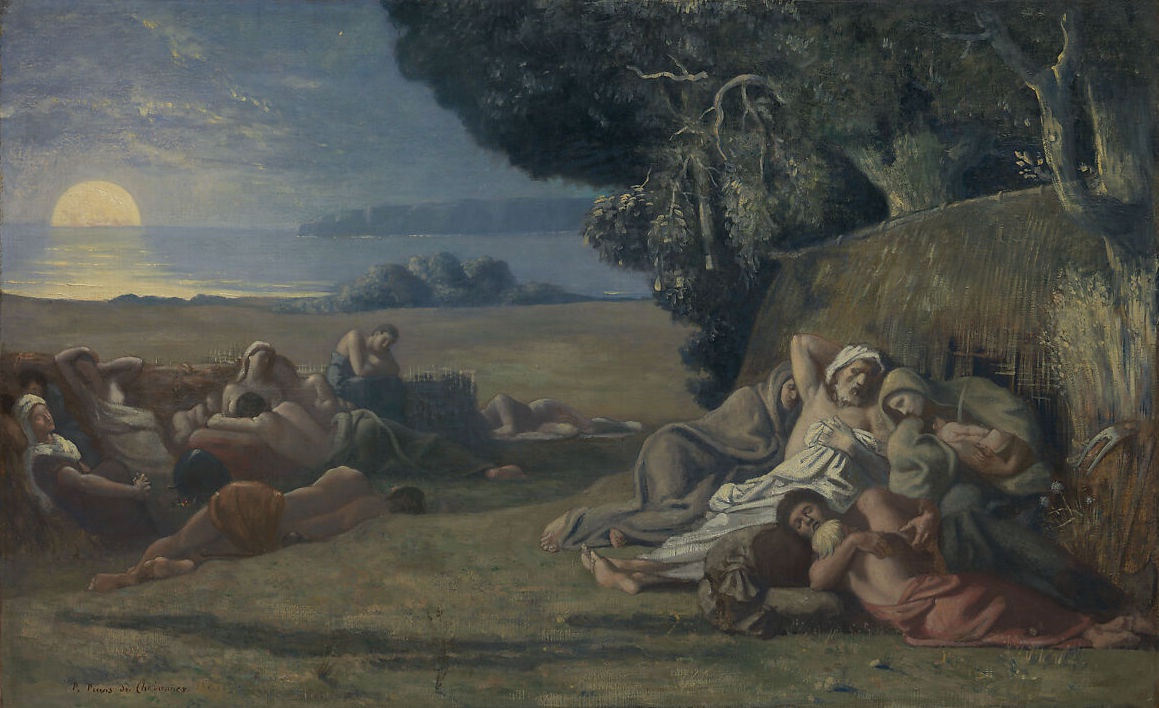In paintings of Provence and Wales made before the First World War, Augustus John and his friends treated the landscape as a lively character with a dramatic personality all of its own.
InSight No. 150
Augustus John, Landscape in Wales, c. 1911–13
In or around 1910, Augustus John (1878–1961) began to make small-scale paintings of wide open landscapes. Although he had painted it as an ensemble with figure compositions, he had not previously made landscape the subject of a painting. A prolonged family vacation at Martigues beside the Étang de Berre in Provence, lasting from February to September, introduced him to the expressive potential of landscape. As he wrote later, as he approached by train, he had ‘a feeling that I was going to find what I was seeking, an anchorage at last’. Arriving at Martigues, ‘there was no need to seek further.’
Contrasts of land, water and sky, the full light of afternoon and the half-light of dusk, and the vitality of natural colours—blue, pink, green and pale brown—were a heady revelation to John. It was in Martigues that he gained an appreciation for the qualities of landscape: ‘In Provence’, he wrote, ‘I always look forward to those days when the sun, shining through an atmospheric veil, while casting no shadows, envelops everything in light and colour.’ Working on small wood panels, he would make a sparce pencil outline of his subject before executing a lively plein air oil sketch, which often corrected—but sometimes ignored altogether—the contours of his underlying pencil drawing.

The tradition of landscape oil sketches, originated in eighteenth-century Europe and practised by various artists including Pierre-Henri de Valenciennes, Peder Balke and Lord Leighton, was defined by close attention to specific conditions and rapid execution. Although this working method laid the foundations for Impressionist plein airisme, John’s own work suggests a return to an earlier and less dogmatic method: the artist confronted a subject, attempted to make a picture of modest proportions, and improvised with his medium to secure an accurate effect. Returning to London from Martigues in autumn 1910, John was ready to exhibit the fruit of his efforts and a solo exhibition at the Chenil Gallery, opening that November, included forty-eight ‘provençal studies and other works’.

Even as he maintained an affection for Provence, returning regularly to the Villa Ste Anne in Martigues until 1928, his friendship with a young Slade student led him to discover the landscape of North Wales. James Dickson Innes (1887–1914), known to acquaintances as Dick, ‘suggested [John] should join him there some time’. As John later recalled, on his first visit with Innes in 1911, ‘[o]ur meeting at Arenig was cordial, and yet I seemed to detect a certain reserve on his part: he was experiencing, I fancy, the scruples of a lover on introducing a friend to his best girl—in this case, the mountain before us, which he regarded, with good reason, as his spiritual property.’ John perceived the world in terms of male-female relationships, and to him the landscape was definitively feminine. Referring to a possible ‘New Religion’, he expressed a preference for ‘the rehabilitation of the Earth-Mother and Child’. In his landscape paintings, such soulful concerns are latent, and relate closely to the symbolism of Puvis de Chavannes, whose paintings of landscape often suggested a higher connection between humankind and the natural world.

Considering his early demise at the age of twenty-seven, caused by tuberculosis, Innes produced a considerable oeuvre of landscape paintings. John remarked his ‘prodigious’ activity amongst the mountains: ‘he rarely returned of an evening without a couple of panels completed. These were, it is true, rapidly done, but usually meant long rambles over the moors in search of the magical moment.’ John’s own landscape panels witness the same search for ‘the magical moment’, which arose from the timely coincidence of fading daylight, fantastic cloudscapes and an advantageous outlook. This was prima painting, in which the artist had to capture his subject in a single layer of paint applied wet-on-wet. John often used the unpainted interstices between marks, the warm buff colour of the exposed support, to create a material contrast with the liquidity of paint, while the fine paint surface sometimes produced a cross-rhythm as the texture of a brushstroke cut across the woodgrain of the panel.

John and Innes stayed near Arenig on various occasions between 1911 and 1913, sometimes together and sometimes not. The biographer Michael Holroyd suggested that John entered with Innes ‘a brief period of mutual apprenticeship’, in which they learned from one another and widened their technical and emotional grasp of the landscape. But the sun soon went down on their adventures, bringing an end to twilit painting sessions and heralding Innes’s early demise, the outbreak of war in 1914 and new directions in John’s work. Yet for a few short years, they produced—along with their erstwhile friend Derwent Lees—a remarkable group of paintings rich with the sap of youthful discovery.

IMAGES
French, The Sky at Sunrise, 4 May 1821, National Gallery, London
Exhibition catalogue for Provençal Studies and Other Works (1910, Chenil Gallery)
Pierre Puvis de Chavannes, Sleep, c. 1867–70, Metropolitan Museum of Art, New York
James Dickson Innes, Sunset, Arenig, c. 1911–12, Private Collection
Augustus John, The Arenig Fach, c. 1911, oil on panel, 12 x 16 in



